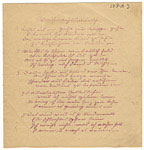|
|
|
LanguageCanadian society is split along many fault lines: regions, economies, political classes, cultural or ethnic origins, and income. Nothing, however, has divided citizens as much as language differences. Indeed, some define this nation as two linguistic groups, French and English, constantly at odds with each other. Education, commerce and government are the battlegrounds of Canada's language wars, and always have been. By 1700, Aboriginal peoples were divided into twelve language families, and they have largely remained so*. French-speaking Canadians totaled 31% of our population in 1931 and this is essentially the same thirty years later. Anglophones comprised 57%. Historically, the two founding European peoples, French and British, struggled with ways and means to achieve linguistic peace, but such episodes as the Riel Uprising (1869), the Manitoba Schools Question (1890), the Conscription Crisis (1917) and the passage of Bill 101 in Quebec (1977) ensured that our language fault line remained a pitfall for those seeking a fully unified country. Of all the attempts to bridge the gap between French and English, and assimilate newcomers into Canadian society, none has been pursued as vigorously or as successfully as the use of the public school system. Our laws ensure that all youth, native or immigrant, remain in school until the age of 16. With the annual curricula we use, each child has a few years of either French or English instruction. The workplace is second in importance as a place where newcomers can strengthen their language skills. The media also have a fundamental impact on one's ability to learn new expressions or question the way things are. In fact, unless a person is virtually locked away at home or otherwise isolated from contact with the outside, it is impossible not to learn the dominant language, at least to a working degree.*** This combination of formal training and learning in daily life is Canada's way of integrating all its citizens into one of two language families. |
Bibliography · Links · Credits · Index


